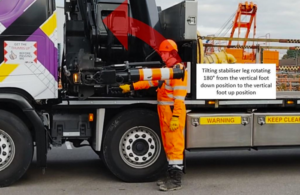HSE Safety Alert: Lorry loaders crush risk from powered tilting stabilisers
The HSE is aware of 3 fatal incidents in Great Britain since 2019, where the operator of a lorry loader has been crushed against the bodywork of the vehicle by the retracting leg of a powered tilting stabiliser.
On some lorry loaders with powered ‘tilting’ stabilisers people can be crushed against the bodywork of the vehicle when the stabilisers are being retracted.
There is a risk of serious injury or death when a powered tilting stabiliser is being rotated to a vertical position. If a stabiliser is retracted towards the vehicle when not vertical, the operator or others positioned in the danger zone can be crushed.
Outline of the problem
Tilting stabilisers are rotated to a vertically up position for stowage. Powered stabiliser tilt is controlled either by levers at the crane base or by remote control. Tilting stabilisers may rotate either towards the front or the rear of the vehicle, depending on machine design. On some lorry loaders, stabilisers on opposite sides of the same vehicle may tilt upwards in different directions.
HSE is aware of three fatal incidents in Great Britain since 2019 where the operator of a lorry loader has been crushed against the bodywork of the vehicle by the retracting leg of a powered tilting stabiliser. In each instance the retracting stabiliser leg struck the operator while it was only part-rotated to an approximately horizontal position.
Rotating tilting stabiliser leg 180° from the vertical foot down to the vertical foot up position
Owners should seek safety improvements from manufacturers
Lorry loader owners should seek safety improvements from manufacturers to eliminate or reduce the crushing risk on machines currently in use.
Consult with your manufacturer at the earliest opportunity to secure reasonably practicable improvements to reduce the risk of crushing within the existing general configuration and certification of the machine. For example, it may be possible to:
- install software modifications to prevent the stabiliser from retracting unless the leg is in the vertical stowage position
- install interlocks to prevent the stabiliser legs being retracted unless the leg is vertical
- disable the base controls by removing the fixed levers and use only remote controls.
Keep records of discussions with manufacturers.
Risk assessment and control
Those involved in lorry loader operations should include the crushing hazard from tilting stabilisers in their risk assessments and include appropriate control measures in all lorry loader procedural documentation, such as lift plans.
Owners of affected lorry loaders should ensure that residual risk warning decals are present and visible to operators in and near the crushing danger zone(s). Owners should consult lorry loader manufacturers to obtain new or replacement decals.
Where base control levers are removed and remote control is the primary mode of use, the fixed levers should be stored for use in an emergency. A label should be affixed to the fixed control panel indicating the lever storage location.
Procedural documentation must stress the importance of operating from a safe position when operating stabilisers using remote-control.
Safe operation
Users should ensure that their operators are competent, are familiar with the functions of the type of stabiliser fitted and have been trained in correct use. The following key safety points apply to those involved in lorry loader operations:
- the risk of crushing is increased on the side where the tilting stabiliser rotates towards the operator or levers at the crane base
- tilting stabiliser legs should be pinned or locked in the vertical position before the horizontal stabiliser beam is deployed or retracted
- it is essential that operators fully observe all movements of the stabilisers during deployment and stowage
- operators must be made aware that operation of the tilt-up function must be separate from the retraction of the stabiliser beam (operators should not use both functions simultaneously)
- operators must be fully conversant with the manufacturer’s instructions regarding the deployment and stowage of tilting stabilisers. There can be considerable variation between different systems
- operators, or others, must not be positioned in (or be required to lean or reach into) danger zones where there is a risk of crushing
- where the stabiliser is only partially deployed, the risk is increased. In this case, consideration should be given to repositioning the vehicle to ensure further extension of the stabiliser beam is achievable prior to the tilt-up leg being deployed
- where available, remote controls should be used for the operation of stabilisers and the operator should stand in a position suitable to observe the operation but outside of the danger zone
- all loader cranes with remote-control of powered stabilisers have the option to use emergency fixed levers at the crane base. The emergency fixed levers are only required in the event of remote-control failure, following confirmation that a) the spare remote-control battery does not resolve the issue, and b) the remote-control ‘umbilical cord’ is inoperable. Fleet owners are advised to ensure that the umbilical cord is always available in the cab and is fit for use. Should the emergency fixed levers need to be used, this guidance applies in the same way as it would to standard controls.
Training
Those publishing training and guidance material should update their publications to incorporate information on the additional hazards identified with powered tilting stabilisers.
Training provision should include coverage of this Safety Notice, regardless of stabiliser type (as operators may move between vehicles).
Those conducting familiarisation training on lorry loaders (such as during new vehicle handover or when operators move to a different vehicle) should include coverage of this Safety Notice.




